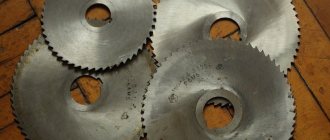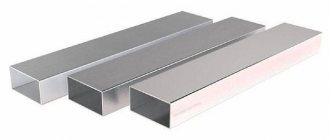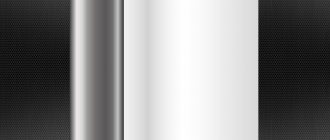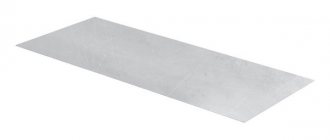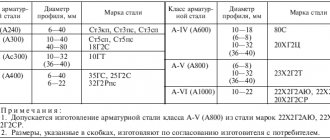Among the main mechanical features, the following characteristics should be highlighted:
- Hardness, according to the Brinell method;
- Yield for strain, which is displayed in MPa;
- Operation under a certain load;
- Indicators of shape change during narrowing and rupture.
The strength class corresponds exactly to the marking of 345 steel. This includes many other grades, which may even differ in their manufacturing method and chemical composition. GOST describes the main types of rolled metal:
- Profiles with designated thickness;
- Round, Varietal and Shaped;
Hardness is measured based on the Vickers, Rockwell and Brinell methods. Preference is given based on the type of product in the production of which steel marked 09g2s is used. Also, it is important to know the hardness index if welding work is necessary so that the seam remains strong.
Density varies depending on the chemical composition, and on average reaches 7800 kg/m3. However, alloying components have the ability to increase weight as well as significantly reduce it. In the second case, copper or cobalt can play a role, and in the second, tungsten.
Technical features describe the basic requirements for working with materials from which it is planned to manufacture steel products for servicing gas systems and other facilities in many areas of industrial activity.
The allowable stress for this steel grade depends on the following factors:
- Temperature conditions at which operation is planned;
- Brand and strength class;
- Thickness.
Modern European analogues are most consistent with the mechanical features of the specified brand. But the chemical composition does not have to be the same. The Bulgarian version should be highlighted separately, which is very similar to the domestic marking 09g2s.
Critical point temperature
Impact strength
Impact strength, KCU, J/cm2
Delivery condition, heat treatment
| +20 | -40 | -70 | |
| GOST 19281-73. Long and shaped rolled products with a cross section of 5-10 mm. | 64 | 39 | 34 |
| GOST 19281-73. Long and shaped rolled products with a cross section of 10-20 mm. | 59 | 34 | 29 |
| GOST 19281-73. Long and shaped rolled products with a cross-section of 20-100 mm. | 59 | 34 | |
| GOST 19282-73. Sheets and strips with a cross section of 5-10 mm. | 64 | 39 | 34 |
| GOST 19282-73. Sheets and strips with a cross section of 10-160 mm. | 59 | 34 | 29 |
| GOST 19282-73. Sheets after hardening, tempering (Transverse samples) with a cross section of 10-60 mm | 49 | 29 |
Endurance limit
Yield strength
Physical properties
| Test temperature, °C | 20- 100 | 20- 200 | 20- 300 | 20- 400 | 20- 500 | 20- 600 | 20- 700 | 20- 800 | 20- 900 | 20- 1000 |
| Linear expansion coefficient (α, 10-6 1/°С) | 11.4 | 12.2 | 12.6 | 13.2 | 13.8 |
Hardenability
| Distance from the end, mm / HRC e | |||||||||
| 1.3 | 3 | 6 | 9 | 12 | 18 | 24 | 30 | 36 | 42 |
| 52.0 | 52.0 | 51.5 | 49.5 | 48.5 | 45.5 | 44.0 | 43.5 | 43.5 | |
| Critical diameter in water, mm | Critical diameter in oil, mm |
| 70 | 45 |
Advantages and disadvantages
- Low specific gravity.
- High strength.
- Durability. Service life under normal operating conditions is more than 30 years.
- Wide temperature range for use without deformation of the structure (-70 - +425 °C).
- Good weldability. When welding, the grain size does not change and ductility is maintained.
- No temper brittleness.
- Economical.
- Resistance to mechanical stress.
- Ease of processing.
This material has one significant drawback - low resistance to rust. This narrows the scope of application of the alloy.
Steel 09G2S
| Profile | Size(mm) | NTD |
| Circle | GOST 19281-73, GOST 2590-2006, GOST 2591-2006 | |
| Calibrated circle | GOST 19281-73, GOST 2590-2006, GOST 2591-2006 | |
| Square | GOST 19281-73, GOST 2590-2006, GOST 2591-2006 | |
| Forging | GOST 1133-71 |
Characteristics of steel 09G2S
The operational and technical characteristics of products made from steel 09G2S are regulated by GOST 19281-73.
This alloy contains 11 elements. The percentages of all components of the substance are presented in the table below and in the diagram.
| Cr | Mn | Ni | Mo | C | Fe | P | S |
| up to 0.3 | 1,3 – 1,7 | up to 0.3 | 0,25 – 0,4 | up to 0.12 | 96-97 | up to 0.035 | up to 0.04 |
Steel 09G2S , whose Brinell hardness is 450-490 MPa, is one of the most popular grades of steel for buildings in construction. But this is not the only advantage of steel. With a specific gravity of 7.85 g/cm3 after processing and obtaining a 2-phase structure, the steel acquires a high level of endurance limit while simultaneously increasing (3.0-3.5 times) cycles until structural failure.
Structural steel 09G2S is capable of maintaining its original characteristics at high pressure in the temperature range from -70 ˚С to +425 ˚С. Steel 09G2S is resistant to loads with a variable force vector, durable and responds well to heat treatment.
Steel 09G2 is divided into categories depending on the requirements for impact bending tests. The characteristic is the impact strength of KCU - the ability of the material to absorb mechanical energy during the process of deformation and destruction under the influence of load.
The category is indicated along with the steel grade. For example, steel with category 12 is designated as 09G2S-12 . Category 15 - 09G2S-15. The difference between them is the impact strength temperatures.
Strength class 09G2S is described by GOST 19281-2014.
Interpretation of steel 09G2S
- 09 – quantitative fraction of carbon content in the alloy (0.09%);
- G2 is manganese and its part in the entire volume fluctuates around 2% (the exact figure ranges from 1.3 to 2%);
- C – denotes silicon, the absence of numbers after the symbol indicates that it is less than 1%.
Advantages of steel 09G2S
- High mechanical strength
- Durability – the service life of parts made from this steel is more than 30 years
- Wide operating temperature range – from -70°С to +425°С
- No tendency to temper brittleness
- After tempering, the viscosity of steel does not decrease
- Does not lose ductility and does not change grain size when welding elements
Application of steel 09G2S
- Heating and steam boilers;
- Welded complex structures
- oil industry - pipe laying in the far north of Russia, installation of complex welded parts;
- mechanical engineering – production of steam boilers and other equipment for working at high temperatures;
- In simple street structures
The specific gravity of this alloy is 7.85 g/cm3. The weldability of this steel is not limited.
Welding methods:
- manual arc (RDS)
- argon-arc (AS) submerged arc and gas protected
- electroslag (ESS)
The critical point temperature is:
- Ac1 = 725°
- Ac3(Acm) = 860°
- Ac3(Acm) = 860°
- Ar1 = 625°
The material has no flake sensitivity and no tendency to temper brittleness.
Forging temperature:
- start – 1250°С
- end – 850°С
Cutting machinability is available in the normalized tempered state δB = 520 MPa, Kυ b.st = 1.0 K υ tv. spl=1.6
Purpose
Structural low-alloy silicon-manganese steel 09G2S is used for the manufacture of elements and parts of welded structures operating under pressure in the temperature range -70 +4250C.
Almost the entire line of metal products is made from steel 09G2S, namely steel I-beam, hot-rolled steel sheet, used and unused pipes, strip, circle. St 09G2S has received such widespread use due to its mechanical, chemical and physical properties. Such as good weldability, exposure to external environments, high strength under load.
What does the transcript look like?
Knowing the labeling makes it possible to directly understand what exactly is offered by the manufacturer and what features the product has. From a technical point of view, the marking 09g2s means the following:
- 09 - exact proportion of carbon in the total alloy;
- G2 - presence of manganese and its fluctuation in the total volume - 2%;
- C—presence of silicon, the proportion of which does not exceed 1%.
However, one should not think that the composition of steel includes only those elements that are indicated in the marking.
In addition to manganese and silicon, the overall composition is supplemented by sulfur, nitrogen, nickel, copper and phosphorus. However, the share of additional components rarely exceeds 1%, so they are not mentioned in the labeling.
Also, decoding concerns not only doping, but also other criteria. For example, the following should be included here:
- Structure and changes after the hardening process;
- Main purpose;
- Manufacturing method;
- Chem. composition of the material.
As a result, there are analogues for these indicators on the domestic market. You can often hear that 09g2s is steel 345. However, the second indicator is intended for builders and does not mean the chemical composition, but the fluidity indicator, which corresponds to the steel standard.
Steel grade 09G2S interpretation:
09 - indicates the average carbon content in steel 0.09% G - manganese 2 - 2 indicates that the steel contains less than 2% manganese C - silicon
Delivery by special transport of sheets 10HSND, 15HSND GOST 6713-91 with a width of 2.5 meters:
Sheet 09G2S GOST 19281-14 2mm - 140mm:
Sheet 09G2S GOSTmm, 30mm, 40mm, 50mm:
Sheet 09G2S GOST 19281-14 2mm, 3mm, 4mm, 5mm:
Application area
The main areas in which steel of this marking is used are as follows:
- Shaped products;
- Sheet metal;
- Production of hot-rolled strips.
As mentioned above, analogues can be easily welded. The characteristics mentioned above make it possible to use them in products that require an increased level of wear resistance: construction angles, steel beams, and channels.
The technical features of the brand are necessary in the manufacture of automobiles, construction and various fields of industry. It is worth noting that the optimal temperature range makes it possible to use steel in products and places where significant deformation occurs over a certain period of time. However, the limit value of -70 degrees ensures successful use in the harsh conditions of Siberia.
Steel 09g2s-15 is popular in the modern market. It is used in all represented areas of industry. It should be added that in addition to welding, installation can be carried out on the basis of a bolted connection. The material exhibits excellent resistance to chemical and biological influences, which is why it is successfully implemented in chemical plants and port stations.
Also, in the north of the state, many kilometers of pipeline routes are made of this particular grade of steel. Metallurgists have successfully used the temperature regime of the material and introduced it into appropriate conditions where the mechanical and physical properties will be manifested in the best possible way.
Another reason for using steel with this marking in the production is the high level of efficiency, which is created due to adequate pricing and excellent speed of construction of structures, which allows reducing costs for specific enterprises.
Welding Features
Working with steel of this marking is carried out on the basis of special requirements, which dictate the need to comply with basic rules to achieve an effective result.
The importance of maintaining the mechanical stability of the material at the seams is the most important task, which becomes the basis for the safety of structures and people. However, under normal conditions it is difficult to achieve excellent results.
For example, the condition for eliminating overheating is determined by the use of currents of 40-50A per 1 mm of electrode. The work requires accompanying hardening of materials at temperatures up to 600 degrees.
But, based on the boundary parameters of the alloy, it is possible to carry out independent calculations for welding work. Cooling is done in air or water. By following the basic technology, it is possible to achieve high quality that will not be inferior to that of expensive alloys.
Recycled raw materials
The variety of secondary raw materials can surprise many specialists. To obtain information, simply enter the metal markings into the search query and get results with the following types of products:
Steel 09g2s is a material that is successfully used in many areas of industrial activity, and also exhibits its positive features in the form of mechanical stability and a wide temperature range.
Manufacturing
The basis for the manufacture of the material is cast iron. It goes through a long optimization process, during which the amount of carbon in the composition increases and the basic properties of the metal improve. To achieve certain technical characteristics, additional alloying additives are added.
- Open-hearth method. An industrial furnace is loaded with scrap, cast iron, charge, and additional components. A pile of metal is melted using a torch of burning fuel. Once the scrap is melted, alloying components are added to the bath. When carrying out the procedure, special open-hearth furnaces are used, which can smelt up to 900 tons of metal at a time.
- Electrothermal method. During production, an industrial electric furnace is used, with which you can accurately set the heating mode and control the metal production process. The main advantage of the technology is the ability to obtain metal with the lowest content of harmful impurities (phosphorus, sulfur). Thanks to the ability to set very high heating temperatures, it is possible to obtain specialized types of steel with unique technical characteristics.
- Converter. Molten cast iron is poured into the melting apparatus and purged with oxygen. The impurities contained in the cast iron begin to oxidize. Oxidation releases a large amount of heat, which increases the overall temperature to 1600 °C.
Range of products made from steel 09G2S
The metallurgical enterprises of our country produce the following rolled products:
- 19281-73 Long and shaped rolled products;
- 19282-73 Sheets and strips.
That is, on the metallurgical products market, consumers can purchase a channel, angle, sheet, etc. We can safely say that such a wide range of products is ensured precisely by the properties and, of course, the price of this material.
For comparison, we can say that on average the price of a hot-rolled sheet of 09G2S steel is 43,000 rubles per ton, while a sheet of ordinary steel costs approximately 41,000 - 43,000. But the properties of the material described cover all the costs associated with its acquisition and processing.
SHEET G/K 09G2S
Hot-rolled sheet 09G2S 2x1200x2300 GOST 17066-94 upon request Hot-rolled sheet 09G2S 3x1100x2400 GOST 17066-94 upon request Hot-rolled sheet 09G2S 4x1500x6000 GOST 19281-14 upon request Hot-rolled sheet 09G2S 5 х1500х6000 GOST 19281-14 on requestGlass sheet 09G2S 6х1500х6000 GOST 19281-14 on upon request Sheet g/k 09G2S 8x2120x6500 GOST 19281-147,980104 000,00Hot-rolled sheet 09G2S 10x2100x8000 GOST 19281-143,550104 000,00Hot-rolled sheet 09G2S 12x2350x7400 GOST 19281-145,971104 000,00Hot-rolled sheet 09G2S 14x2200x10800 GOST 19281-14on request Hot-rolled sheet 09G2S 16x1900x11200 GOST 19281-1410,224104 000,00Hot-rolled sheet 09G2S 20x2350x8500 GOST 19281-14 upon request Hot-rolled sheet 09G2S 25x1800x10500 GOST 19281-14 upon request Hot-rolled sheet 09G2S 27x2100x9900 GOST 19281-14 upon request Hot-rolled sheet 09G 2S 30x2050x10500 GOST 19281-14 upon requestGlass sheet 09G2S 32x2300x8550 GOST 19281-14po on requestHoc sheet 09G2S 36x2450x10500 GOST 19281-14on requestHook sheet 09G2S 40x2300x10000 GOST 19281-14on requestHose sheet 09G2S 45x2500x5500 GOST 19281-14on requestHook sheet 09G2S 50x2500x6800 GOST 19281-14 upon requestAvailability, sheet sizes, price please check with the sales department.
Available sheets: thickness 2mm-60mm width 1500-2500 mm length 2500-12500 mm
Analogs and substitutes for steel 09G2S
When developing metal structures, a design engineer can replace 09G2S with the following domestically produced steels 09G2, 09G2DT, 09G2T, 10G2S. In addition, imported analogues are widely used in the domestic industry, such as: A 516-55 (ANSI - USA), SM41B (JIS - Japan).
Steel 09G2S - domestic analogues
Foreign analogues of Steel 09G2S
| Germany | Japan | China | Bulgaria | Hungary | Romania |
| DIN,WNr | JIS | G.B. | BDS | MSZ | STAS |
| 13Mn6 9MnSi5 | SB49 | 12Mn | 09G2S | VH2 | 9SiMn16 |
| Mechanical properties | |
| σB | temporary tensile strength (tensile strength), MPa |
| σ0.2 | conditional yield strength, MPa |
| σcom | compressive strength, MPa |
| σco0.2 | compressive yield strength, MPa |
| σ0.05 | elastic limit, MPa |
| σben | bending strength, MPa |
| σ-1 | endurance limit during bending test with a symmetrical loading cycle, MPa |
| δ5, δ4, δ10 | relative elongation after rupture, % |
| ψ | relative narrowing, % |
| ν | relative shift, % |
| ε | relative settlement at the appearance of the first crack, % |
| τK | ultimate torsional strength, maximum shear stress, MPa |
| τ-1 | endurance limit during torsion testing with a symmetrical loading cycle, MPa |
| KCU and KCV | impact strength, determined on a sample with concentrators of the U and V types, J/cm2 |
| HRСе and HRB | Rockwell hardness (scale C and B respectively) |
| HB | Brinell hardness |
| H.V. | Vickers hardness |
| HSD | Shore hardness |
| Physical properties | |
| E | normal modulus of elasticity, GPa |
| G | modulus of elasticity in torsional shear, GPa |
| ρn | density, kg/m3 |
| λ | thermal conductivity coefficient, W/(m∙°C) |
| ρ | electrical resistivity, Ohm∙m |
| α | linear thermal expansion coefficient, 10-61/°С |
| With | specific heat capacity, J/(kg∙°С) |
Comparison with another steel grade
For example, for 09g2s and st3 the difference is determined primarily by the carbon content. For St3sp it is 10-20 times higher than what is found in the low-alloy alloy.
St3sp – refers to carbon alloys. This grade of steel is characterized by high brittleness and rapid destruction at low temperatures. If the brand being described has a lower limit of -70 degrees, then the object of comparison is only -20.
The quality of St3sp is ordinary, which indicates a likely high presence of sulfur and phosphorus. Then, like 09g2s is high quality. All other advantages are already in the previous description. It only remains to note that the cost of this brand is significantly higher than the price of St3sp.
Video about low alloy steels:
Which is better: galvanized or stainless steel?
In order to successfully solve various technological problems and not get confused: buy a galvanized sheet instead of a stainless steel one, contact a trusted, reputable supplier. Although both metals are corrosion-resistant, and when constructing structures with a service life of no more than 10 years, it is quite possible to get by with cheaper galvanized steel, for critical objects it is still not worth skimping on quality.
A guarantee that you are purchasing a certified product will be choosing as a partner a reliable supplier with attractive market offers. Today we are the best and are ready to supply any volumes of highest quality metal products in the shortest possible time.
CONTROL METHODS
4.1. Sampling to determine the chemical composition is carried out according to GOST 7565.
4.2. Chemical analysis of steel is carried out according to GOST 22536.0—GOST 22536.12, GOST 27809, GOST 12346, GOST 12347, GOST 12348, GOST 12350, GOST 12351, GOST 12352, GOST 12355, GOST 12356, GOST 12357, GOST 1 2358, GOST 12359, GOST 12361, GOST 12364, GOST 18895 or other methods that provide the necessary accuracy of analysis.
In case of disagreement in quality assessment, the assessment is carried out using the methods established in the standard. (Changed edition, Amendment No. 1).
4.3. Carbon equivalent (Ce) is calculated using the formula
where C, Mn, Si, Cr, Ni, Cu, V, P are the mass fractions of carbon, manganese, silicon, chromium, nickel, copper, vanadium and phosphorus.
4.4. Control of surface quality and dimensions of rolled sheets according to GOST 14637, long products - according to GOST 535.
4.5. Delamination of rolled products during cutting is controlled by inspection of the edges and ends without the use of magnifying devices.
If necessary, the quality of the metal on the edges of sheets and universal strips is checked by removing chips: in this case, bifurcation of the chips serves as a sign of discontinuity of the metal.
4.5.1. Ultrasonic testing of the continuity of rolled sheets is carried out in accordance with GOST 22727.
4.6. Sampling and production of samples for mechanical and technological tests are carried out in accordance with GOST 7564. Samples are cut lengthwise from shaped rolled products and universal strips, and across the rolling direction from sheet metal. When testing for impact bending on samples with a sharp notch, samples are taken along the rolling direction.
For rolled products with a diameter or side of a square greater than those indicated in the table. 1 and 7, it is allowed to determine the mechanical properties on samples cut from blanks, forged or rolled to the dimensions regulated by Table. 1 and 7. The standards of mechanical properties in this case must correspond to table. 1 and 7.
(Changed edition, Amendment No. 1).
4.7. From each rod, sheet, universal strip, roll selected for control, one sample is taken for tensile and bending tests, and two samples for each temperature are taken to determine impact strength. The quality of bent profiles is controlled by the workpiece.
4.8. Tensile testing of rolled products is carried out on samples of five times the length in accordance with GOST 1497. (Changed edition, Amendment No. 1).
4.9. The bending test is carried out according to GOST 14019.
4.10. Determination of the impact strength of rolled products with a nominal thickness of up to 10 mm inclusive is carried out on samples of type 1, 2 or 3, and for categories 8 and 9 - types 11, 12, 13 according to GOST 9454. For rolled products with a thickness of more than 10 mm, the impact strength is determined on samples of type 1, and for categories 8 and 9 - type 11 according to GOST 9454.
The impact strength of shaped and strip products with a thickness of 3-4 mm, and sheet products with a thickness of less than 5 mm can be determined on samples with a width equal to the thickness of the product.
(Changed edition, Amendment No. 1).
4.11. Impact strength after mechanical aging is determined according to GOST 7268 on samples with a U-type concentrator. The thickness of the samples must correspond to those adopted in clause 4.10.
4.12. When testing samples with a type U concentrator, a reduction in impact strength on one sample is allowed by 15%; when testing samples with a type V concentrator, a reduction in impact strength on one sample is allowed by 30%; in this case, the average value of the test results must not be lower than the standards in Table. 6 and 7.
4.13. When the manufacturer uses statistical and other non-destructive methods for monitoring mechanical properties in accordance with regulatory and technical documentation, the manufacturer may not carry out control of mechanical properties according to the methodology provided for by this standard. The manufacturer guarantees compliance of manufactured products with the requirements of this standard. In case of disagreement in quality assessment and during periodic product quality checks, control methods provided for in this standard are used.
Analog (substitute) of steel grade 09G2S GOST 19281-14:
steel grade 09G2DT, 09G2, 10G2S, S345
Additional conditions for rolled metal products at the request of the Buyer in accordance with GOST, TU, etc. NTD: 1. 100% UZK 0, 1, 2, 3 continuity classes in accordance with GOST 22727-88. 2. Trim edge. 3. Flatness: high, especially high. 4. Heat treated: controlled rolling, normalizing, high tempering, high tempering. 5. Z-properties according to GOST 28870-90, relative narrowing in the direction of the thickness of the rolled product, no less than 15%, 25%, 35%.
Products group:
| NAME | WEIGHT, TN | PRICE, RUB/t with VAT | |||

